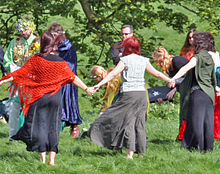Various rites of passage can be found within Wicca. Perhaps the most significant of these is an initiation ritual, through which somebody joins the Craft and becomes a Wiccan. In British Traditional Wiccan (BTW) traditions, there is a line of initiatory descent that goes back toGerald Gardner, and from him is said to go back to the New Forest coven; however, the existence of this coven remains unproven.[68] Gardner himself claimed that there was a traditional length of "a year and a day" between when a person began studying the Craft and when they were initiated, although he frequently broke this rule with initiates. In BTW, initiation only accepts someone into the first degree. To proceed to the second degree, an initiate has to go through another ceremony, in which they name and describe the uses of the ritual tools and implements.[69] It is also at this ceremony that they are given their craft name.[69] By holding the rank of second degree, a BTW is considered capable of initiating others into the Craft, or founding their own semi-autonomous covens.[69] The third degree is the highest in BTW, and it involves the participation of the Great Rite, either actual or symbolically, as well as ritual flagellation.[70] By holding this rank, an initiate is considered capable of forming covens that are entirely autonomous of their parent coven.[70]
This three-tier degree system following initiation is largely unique to BTW, and traditions heavily based upon it. The Cochranian tradition, which is not BTW, but based upon the teachings ofRobert Cochrane, does not have the three degrees of initiation, merely having the stages of novice and initiate.
Some solitary Wiccans also perform self-initiation rituals, to dedicate themselves to becoming a Wiccan. The first of these to be published was in Paul Huson's Mastering Witchcraft (1970), and unusually involved recitation of the Lord's Prayer backwards as a symbol of defiance against the historical Witch Hunt.[71] Subsequent, more overtly pagan self-initiation rituals have since been published in books designed for solitary Wiccans by authors like Doreen Valiente, Scott Cunningham and Silver RavenWolf.
Handfasting is another celebration held by Wiccans, and is the commonly used term for their weddings. Some Wiccans observe the practice of a trial marriage for a year and a day, which some traditions hold should be contracted on the Sabbat of Lughnasadh, as this was the traditional time for trial, "Telltown marriages" among the Irish. A common marriage vow in Wicca is "for as long as love lasts" instead of the traditional Christian "till death do us part".[72] The first ever known Wiccan wedding ceremony took part in 1960 amongst the Bricket Wood coven, between Frederic Lamond and his first wife, Gillian.[73]
Infants in Wiccan families may be involved in a ritual called a Wiccaning, which is analogous to a Christening. The purpose of this is to present the infant to the God and Goddess for protection. Despite this, in accordance with the importance put on free will in Wicca, the child is not necessarily expected or required to adhere to Wicca or other forms of paganism should they not wish to do so when they get older.[citation needed]

No hay comentarios:
Publicar un comentario